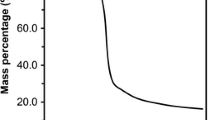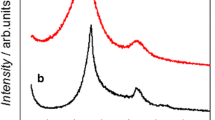Abstract
Nanostructured activated carbons for electrochemical double-layer capacitors were synthesized from depleted fullerene soot (DFS) via KOH activation. The structural and textural properties of the activated DFS were studied using transmission electron microscopy, X-ray diffraction, and nitrogen sorption. Activated DFS with high specific surface areas (SSAs) of up to 2,153 m2 g−1 and narrow pore size distributions (PSDs) was obtained by controlling the KOH/DFS ratio. The activated DFS exhibited excellent capacitive behavior, with a high specific capacitance of 250 F g−1 at a current density of 50 mA g−1 in a 6 M KOH electrolyte, and a high rate performance, with a capacitance retention of up to 80 % at a high scan rate of 200 mV s−1. Moreover, the activated DFS samples exhibited good electrochemical stability; high capacitance retention ratios of >90 % were obtained at a current density of 2,000 mA g−1 for 5,000 cycles with cell voltages of 0.9 and 1.0 V in a two-electrode system. The high electrochemical performance can be attributed to high SSAs, narrow PSDs, and nanoscale particle sizes, which facilitate the formation of electrochemical double layers and rapid ion diffusion.








Similar content being viewed by others
References
Frackowiak E, Béguin F (2001) Carbon materials for the electrochemical storage of energy in capacitors. Carbon 39:937–950. doi:10.1016/s0008-6223(00)00183-4
Pandolfo AG, Hollenkamp AF (2006) Carbon properties and their role in supercapacitors. J Power Sources 157:11–27. doi:10.1016/j.jpowsour.2006.02.065
Zhang LL, Zhou R, Zhao XS (2010) Graphene-based materials as supercapacitor electrodes. J Mater Chem 20:5983–5992. doi:10.1039/C000417K
Wang J, Kaskel S (2012) KOH activation of carbon-based materials for energy storage. J Mater Chem 22:23710–23725. doi:10.1039/C2JM34066F
Frackowiak E, Delpeux S, Jurewicz K, Szostak K, Cazorla-Amoros D, Béguin F (2002) Enhanced capacitance of carbon nanotubes through chemical activation. Chem Phys Lett 361:35–41. doi:10.1016/S0009-2614(02)00684-X
Merino C, Soto P, Vilaplana-Ortego E, de Salazar JMG, Pico F, Rojo JM (2005) Carbon nanofibres and activated carbon nanofibres as electrodes in supercapacitors. Carbon 43:551–557. doi:10.1016/j.carbon.2004.10.018
Barranco V, Lillo-Rodenas MA, Linares-Solano A, Oya A, Pico F, Ibañez J, Agullo-Rueda F, Amarilla JM, Rojo JM (2010) Amorphous carbon nanofibers and their activated carbon nanofibers as supercapacitor electrodes. J Phys Chem C 114:10302–10307. doi:10.1021/jp1021278
Zhu YW, Murali S, Stoller MD, Ganesh KJ, Cai WW, Ferreira PJ, Pirkle A, Wallace RM, Cychosz KA, Thommes M, Su D, Stach EA, Ruoff RS (2011) Carbon-based supercapacitors produced by activation of graphene. Science 332:1537–1541. doi:10.1126/science.1200770
Kroto HW, Heath JR, O’Brien SC, Curl RF, Smalley RE (1985) C60: buckminsterfullerene. Nature 318:162–163. doi:10.1038/318162a0
Howard JB, McKinnon JT, Johnson ME, Makarovsky Y, Lafleur AL (1992) Production of C60 and C70 fullerenes in benzene-oxygen flames. J Phys Chem 96:6657–6662. doi:10.1021/j100195a026
Krätschmer W, Lamb LD, Fostiropoulos K, Huffman DR (1990) Solid C60: a new form of carbon. Nature 347:354–358. doi:10.1038/347354a0
Murayama H, Tomonoh S, Alford JM, Karpuk ME (2004) Fullerene production in tons and more: from science to industry. Fuller Nanotub Carbon Nanostruct 12:1–9. doi:10.1081/FST-120027125
Chen C, Chen J, Wang X, Liu S, Sheng G, Fu J (2000) Fullerenes-extracted soot: a new adsorbent for collecting volatile organic compounds in ambient air. J Chromatogr A 886:313–317. doi:S0021-9673(00)00450-7
Cleveland TG, Garg S, Rixey WG (1996) Feasibility of fullerene waste as carbonaceous adsorbent. J Environ Eng ASCE 122:235–238. doi:10.1061/(ASCE)0733-9372(1996)122:3(235)
Qiu JS, Chen G, Li ZT, Zhao ZB (2010) Preparation of double-walled carbon nanotubes from fullerene waste soot by arc-discharge. Carbon 48:1312–1315. doi:10.1016/j.carbon.2009.01.036
Silva SAM, Perez J, Torresi RM, Luengo CA, Ticianelli EA (1999) Surface and electrochemical investigations of a fullerene soot. Electrochim Acta 44:3565–3574. doi:10.1016/S0013-4686(99)00111-5
Grieco WJ, Howard JB, Rainey LC, Vander Sande JB (2000) Fullerenic carbon in combustion-generated soot. Carbon 38:597–614. doi:10.1016/S0008-6223(99)00149-9
Huang JS, Sumpter BG, Meunier V, Yushin G, Portet C, Gogotsi Y (2010) Curvature effects in carbon nanomaterials: exohedral versus endohedral supercapacitors. J Mater Res 25:1525–1531. doi:10.1557/Jmr.2010.0195
Portet C, Yushin G, Gogotsi Y (2008) Effect of carbon particle size on electrochemical performance of EDLC. J Electrochem Soc 155:A531–A536. doi:10.1149/1.2918304
Egashira M, Okada S, Korai Y, Yamaki J-I, Mochida I (2005) Toluene-insoluble fraction of fullerene-soot as the electrode of a double-layer capacitor. J Power Sources 148:116–120. doi:10.1016/j.jpowsour.2005.02.003
di Stasio S (2001) Electron microscopy evidence of aggregation under three different size scales for soot nanoparticles in flame. Carbon 39:109–118. doi:10.1016/S0008-6223(00)00099-3
Kanowski M, Vieth HM, Lüders K, Buntkowsky G, Belz T, Werner H, Wohlers M, Schlögl R (1997) The structure of fullerene black and the incorporation of C60 investigated by 13C NMR. Carbon 35:685–695. doi:10.1016/S0008-6223(97)00015-8
Xue R, Shen Z (2003) Formation of graphite-potassium intercalation compounds during activation of MCMB with KOH. Carbon 41:1862–1864. doi:10.1016/S0008-6223(03)00161-1
Egashira M, Araki T, Korai Y, Mochida I (1999) Some properties of carbon disks prepared from the toluene insoluble fraction in fullerene soot. Carbon 37:27–31. doi:10.1016/s0008-6223(98)00183-3
Harris PJF, Tsang SC, Claridge JB, Green MLH (1994) High-resolution electron-microscopy studies of a microporous carbon produced by arc-evaporation. J Chem Soc Faraday Trans 90:2799–2802. doi:10.1039/FT9949002799
Zeng XH, Wu DC, Fu RW, Lai HJ, Fu JJ (2008) Preparation and electrochemical properties of pitch-based activated carbon aerogels. Electrochim Acta 53:5711–5715. doi:10.1016/j.electacta.2008.03.035
Yoon SH, Lim S, Song Y, Ota Y, Qiao W, Tanaka A, Mochida I (2004) KOH activation of carbon nanofibers. Carbon 42:1723–1729. doi:10.1016/j.carbon.2004.03.006
Zhai Y, Dou Y, Zhao D, Fulvio PF, Mayes RT, Dai S (2011) Carbon materials for chemical capacitive energy storage. Adv Mater 23:4828–4850. doi:10.1002/adma.201100984
Raymundo-Piñero E, Kierzek K, Machnikowski J, Béguin F (2006) Relationship between the nanoporous texture of activated carbons and their capacitance properties in different electrolytes. Carbon 44:2498–2507. doi:10.1016/j.carbon.2006.05.022
Rufford TE, Hulicova-Jurcakova D, Zhu Z, Lu GQ (2009) Empirical analysis of the contributions of mesopores and micropores to the double-layer capacitance of carbons. J Phys Chem C 113:19335–19343. doi:10.1021/jp905975q
Frackowiak E (2007) Carbon materials for supercapacitor application. Phys Chem Chem Phys 9:1774–1785. doi:10.1039/b618139m
Frackowiak E, Béguin F (2002) Electrochemical storage of energy in carbon nanotubes and nanostructured carbons. Carbon 40:1775–1787. doi:10.1016/S0008-6223(02)00045-3
Portet C, Yushin G, Gogotsi Y (2007) Electrochemical performance of carbon onions, nanodiamonds, carbon black and multiwalled nanotubes in electrical double layer capacitors. Carbon 45:2511–2518. doi:10.1016/j.carbon.2007.08.024
Qu D, Shi H (1998) Studies of activated carbons used in double-layer capacitors. J Power Sources 74:99–107. doi:10.1016/s0378-7753(98)00038-x
Acknowledgments
This work was supported by the National Natural Science Foundation of China (Nos. 20836002, 21003016, 21276045), the Dalian Science and Technology Bureau of China (No. 2011A15GX023), and China Postdoctoral Science Foundation (No. 20100481227).
Author information
Authors and Affiliations
Corresponding authors
Rights and permissions
About this article
Cite this article
Sun, L., Wang, C., Zhou, Y. et al. KOH-activated depleted fullerene soot for electrochemical double-layer capacitors. J Appl Electrochem 44, 309–316 (2014). https://doi.org/10.1007/s10800-013-0636-0
Received:
Accepted:
Published:
Issue Date:
DOI: https://doi.org/10.1007/s10800-013-0636-0




